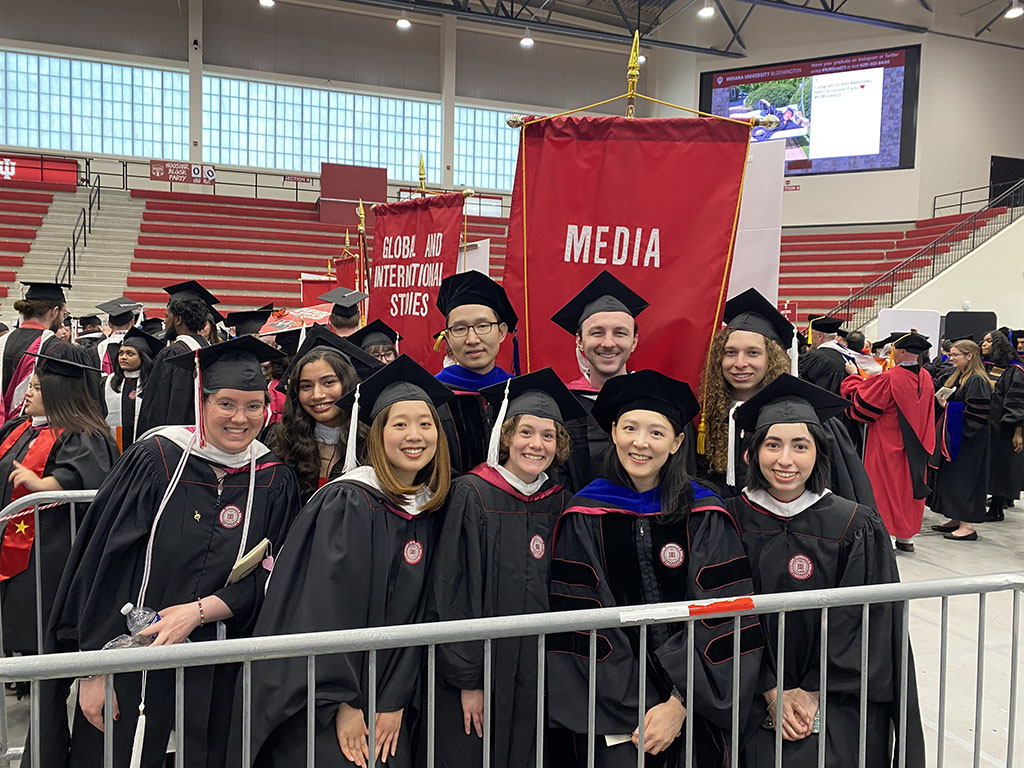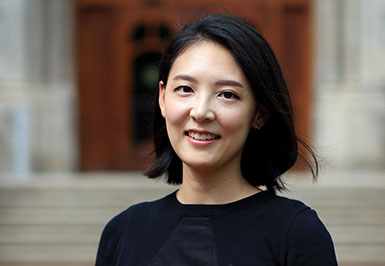21 students complete graduate degrees

Nine Media School students became doctors this academic year, and 12 earned their master’s degrees.
Doctoral students
Under the guidance of faculty members, each doctoral graduate successfully defended and submitted a dissertation as the final step of the Ph.D. program.
Committee members: Andrew Weaver (chair), Stephanie DeBoer, Robert F. Potter, and John Velez Abstract: Moral psychology research, in recent years, has begun to explore the relationships between moral decisions and emotions. Scholars, more specifically, have utilized Haidt’s Moral Foundations Theory to better understand the prosocial effects resulting from moral decisions, and have done so utilizing the video game media. Through an experiment, this study explored the possible relationship between moral decision making and the self-conscious emotion pride, as well as self-esteem. Moreover, this study examined whether identifying with a video game avatar had an impact on moral decisions, pride, or self-esteem, to better comment on avatar identification and moral agency. To test these relationships, this study placed participants into a customized same or customized different category for avatar identification manipulation, and had them play the video game Fallout 3 to determine moral decisions that they made and the possible pride and self-esteem elicitation that resulted from them. Therefore, through this experiment, the findings of this study explore whether or not pride can be elicited from moral decisions, if the identification with an avatar impacts morality, and if pride can be elicited from moral decisions. Findings continue to expand our understanding of moral psychology and emotions, while also exploring the possible prosocial outcomes from moral decisions and video games. This study provides direction for future moral, media, and emotional research endeavors. (PsycInfo Database Record (c) 2023 APA, all rights reserved).Understanding the effects of morality on pride and self-esteem

Twitch Aggression Profile: Exploring Aggression on a Live Mixed-media Platform
Committee members: James Shanahan (chair), Andrew Weaver, Mike Gruszczynski, and Susan Catherine Herring

Abstract: Recent research in communication and information science has pointed towards the popularity of live-streaming media. Most live-streaming platforms support multimodal communication by enabling the viewers to interact with their streamer via chat. This feature significantly extends one-way communication on traditional mass media to two-way communication, wherein viewers can voice their opinions on the content or even participate in the process of content creation. That said, unfortunately, the new media have not only brought enjoyable phenomena; multiple mass shooting incidents, including a recent Buffalo grocery store incident, were broadcasted in real time on the live-streaming platforms by the gunmen. This study addresses a serious social issue—violence/aggression on live-streaming social media—employing Cultivation Theory as a theoretical framework. As the originator of the theory, George Gerbner conducted content analysis of television content to probe violence on the medium in his Cultural Indicators project, this study seeks to conduct a partial replication of his project on Twitch. Both manual content analysis and computational text analysis were utilized to observe three media dimensions of Twitch—game play, streamers’ broadcast speech, and viewers’ chat. Beyond observing the state of aggressive content on Twitch, this study explores the associations between different types of aggression in the three media dimensions: violent game play, streamers’ verbal aggression, and viewers’ aggressive chat messages.
The results of this study manifested that aggression is prevalent on Twitch across all the three media dimensions. Furthermore, the study demonstrated that while violent game play is not significantly associated with either the streamer’s verbal aggression or the viewers’ aggressive chat messages, streamers’ verbal aggression is positively correlated with their viewers’ aggressive messages. This result probably implies that the main narrative that Twitch users focus on is their streamers’ verbal communication rather than game play, which denotes a possible influence of streamers on their viewers. Additionally, the study found that violent game play negatively moderates the positive relationship between streamers’ verbal aggression and their viewers’ aggressive chat messages. Based on prior literature on the limited capacity of attention, it was assumed that watching violent game play may be a cognitive distraction that could disturb Twitch viewers’ focus on their streamer’s talk. The findings are discussed in the context of prior literature and practical implications for content moderation on Twitch.
Committee members: Lesa Hatley Major (chair) Marjorie Hershey, Jason Peifer, and Rob Potter Abstract: This research tests the effects of news stories and visuals on people’s perception of Latino undocumented migrants who live in the United States and are subject to arrest and deportation. A 3 x 2 experimental design is used to study how frames (thematic and episodic) and visual frames (stereotypical and counterstereotypical) affect participants’ attribution of responsibility for arrests and deportations, empathy towards migrants, and the support for a legislative package that would offer a path to citizenship. This study expands framing and visual framing theories by analyzing the combined effects of verbal and textual frames on the public’s view about the arrest and deportation of undocumented immigrants and the support for new public policies. Four-hundred-fifteen U.S. participants were recruited to participate in the experiment. This analysis found that comparing thematic and episodic news stories with no visual did not produce significant effects. However, when visuals and stories were combined significant results emerged. The inclusion of a counterstereotypical visual frame in both episodic and thematic news stories had a positive effect on empathy towards undocumented migrants but it did not affect responsibility and support for immigration reform. The combination episodic news story/stereotypical visual frame was most effective in reducing attribution of responsibility for the Federal government, in increasing the blame for arrests and deportations towards migrants and in decreasing empathy. Overall, reading news stories framed either thematically or episodically with no photograph was effective in increasing attribution of responsibility for the Federal Government. Combining textual and visual frames did not produce any significant effect in terms of support for immigration reform. Participants who identified as a Democrats reported higher levels of empathy, stronger support for immigration reform and they were more likely to blame the Federal government for arrests and deportations than participants who identified as Republicans. Committee members: Sung-Un Yang (chair), Nicholas Browning, Anthony Fargo, and Edward Carmin Abstract: This dissertation addresses three interrelated questions concerning the role of civility and incivility within political news. The first concerns the extent to which a shared understanding exists regarding what is civil and what is uncivil in the realm of U.S. party politics. I reject the argument that there is broad consensus about what constitutes civility and incivility and to what political news content these terms apply. Instead, I demonstrate that perceptions about the civility and incivility of political news are influenced by one’s political identity (i.e., ideological stance and party affiliation). First, I find disagreement between Democrats and Republicans about which party of the two is more civil, with one-third to one-half of the members of each party believing that theirs is the more civil. In addition, I find that Republicans and conservatives mostly converge in belief about the civility of Fox News and incivility of CNN, while Democrats and liberals mostly converge in belief about the civility of CNN and incivility of Fox News. Furthermore, these perceptions about the civility and incivility of political news play mediating roles—both partial and full—in the pathways of partisan selective exposure to like-minded news and avoidance of cross-cutting news. Indeed, civility and incivility are important mechanisms by which selective exposure and avoidance of political news occur. Moreover, I find that civility exerts a greater indirect effect on news consumption behaviors than incivility does by an order of magnitude. Lastly, I discover a range of important effects of exposure to political incivility, including greater knowledge of candidate issue positions, but reduced trust of the out-party candidate and greater affective polarization. I also find that exposure to civility—from cross-cutting media in particular—reduces affective polarization, increases trust of the out-party candidate, and leads to greater involvement in discussions with people with whom one disagrees. Yet, I reject the argument, which is central to many definitions used in the scholarly literature, that exposure to incivility necessarily deters engagement in political discussion. Committee members: Robert Potter (chair), Julia Fox, Ed Hirt, and Annie Lang Abstract: In this dissertation, I examined how listeners process music that varies in complexity and intensity. Experimental participants provided data both in real time during listening and after a song was heard. Employing Lang’s (2006) LC4MP theoretical framework, hypotheses were made concerning how listeners would react to changes in musical complexity and intensity. Research questions were posed as to how listeners’ summative evaluations of the music compared to their dynamically reported listening experiences. To address these, musical complexity and intensity were conceptually defined, and seven commercially available songs were chosen based on the presence of changes in these variables. Continuous response measurement (CRM) was used to examine whether listeners (n=60) reported that changes in the variables of interest occurred where expected. CRM data were also compared to summative self-reported musical complexity and intensity. In a second procedure, psychophysiological measures consisting of heart rate (HR) and electrodermal activity (EDA) were used to examine attention and arousal responses to changes in musical complexity and intensity in listeners (n=41). Results show areas conceptualized as examples of change in complexity and intensity correspond to changes in the CRM data in the expected directions. HR demonstrated orienting responses during intensity changes, with higher EDA during changes that increase either complexity or intensity than during changes that decrease levels of either of these qualities. An exploratory two-step analysis of the continuous versus summative measures using mixed linear models showed that the average and maximum ratings for complexity via CRM throughout a song were significant determining factors of retrospective complexity ratings given just after listening. For musical intensity, a mixed linear model using the average, the maximum, and the ending of CRM ratings outperformed other possible models in predicting retrospective ratings. This study provides interesting depth and context to an earlier study (Jamison-Koenig, 2014), and the implications of these results are discussed. Committee members: Sung-Un Yang (chair), Nicholas Browning, Minjeong Kang, and H. Shanker Krishnan Abstract: This dissertation research conceptualized perceived authenticity in organizational advocacy, developed its measurement scale model, and examined its role in organization-public relationships. Beginning with a multidisciplinary literature review on authenticity and advocacy, this study conducted an online survey using open-ended questions to explore how publics understand the perceptual attributes of the focal concept in order to propose its definition and attributes. In-depth interviews with public relations professionals and scholars were performed to corroborate the dimensions identified from the survey. From survey and interview results, this study proposed a definition of perceived authenticity in organizational advocacy and identified the four sub-dimensions and seven core attributes of the focal concept. With concept explication, a measurement scale of perceived authenticity in organizational advocacy was developed, assessed, and validated through three studies. Before the main studies, content validity of the initial 40 items was evaluated by public relations experts, and pretests were conducted to finalize the revised 24 items. In the first study, reliability and a factor structure of the formative second-order and reflective first-order measurement model were evaluated by using an online survey of a representative U.S. sample (N = 380). After refining measurement items, the reliability and validity of the 23 measures were validated based on the analysis of another online survey using a representative U.S. sample (N = 387). The third study (N = 488) revalidated the reliability and validity of the refined measurement items and proposed the final 23 measures of perceived authenticity in organizational advocacy. In the empirical study of this dissertation project, the significant role of perceived authenticity in organizational advocacy in the quality of organization-public relationships (i.e., trust and distrust) was demonstrated using an online survey (N = 488). The stronger associations of publics’ perceptions of authenticity in organizational advocacy with trust and distrust were compared to two other concepts relevant to authenticity (i.e., transparency and hypocrisy) and their associations with trust and distrust. Based on the results of the construct conceptualization, measurement development, empirical examination of perceived authenticity in organizational advocacy, this dissertation research discussed theoretical and practical implications and addressed limitations and suggestions for future research. Committee members: Joan Hawkins (chair), Michael Martin, Cara Caddoo, and Brett Bowles Abstract: This dissertation investigates questions of geo-politics, capital, and hegemony through the use of the figure of the child in both Classical Hollywood and International Arthouse cinema starting in the Post-War era. The Drama of the Subaltern Child concerns films that have a child or children as their central characters placed within stories that blur, challenge, or erase the moral boundaries of childhood and adulthood that exist in everyday life. I concentrate on those films rated Pg-13, R, and unrated “art films” to discern an under-discussed transnational theme of cinematic discourse expressed through the child and its circumstances. Specifically, this dissertation discusses how the figure of the child is weaponized by filmmakers as a cinematic strategy that coheres around specific character tropes, power dynamics between adult and child, and key cinematic formal structures, that place adult spectators in positions of complicity while manifesting a deliberate cultural critique of the adult-controlled world. Committee members: Joan Hawkins (chair), Faye Gleisser, Joshua Maltisky, Ryan Powell, and Greg Waller Abstract: This dissertation approaches questions of film historiography, sexuality, the avant-garde, and archives through a detailed historical examination of Kenneth Anger’s relationship with and collections at the Kinsey Institute for Research in Sex, Gender, and Reproduction. Drawing upon original research on the correspondences and series that comprise the Anger collections, it builds two primary interventions related to the study of queer excess and archives. Through readings of exemplary donations, it creates an account of both how archival excess functions in a manner that connects the filmmaker and his oft-ignored later films to a wider array of subjects than those he is afforded in traditional scholarly histories, and also how Institute staff have intervened upon Anger’s curatorial decisions in order to create a collaborative reading of his legacy. Each chapter of the dissertation is organized around a specific sub-collection in the Anger archives and a particular strand of archival theory. Chapter 1 examines the entirety of Anger’s relationship with the Institute for Sex Research, showing how the materials that he donated to the Institute were not only framed by the overt archival practices of staff members, but also how often invisible emotional labor and relationship-building conditioned the contents of the archives. Chapter 2 turns to Kenneth Anger’s moving-image donations, establishing both the dual biographical and sexological functions of his contributions to the Kinsey archives and arguing for excess’s disruptive potentials towards positivist research and academic framings of the avant-garde. Chapter 3 follows these points by examining excess as a rupture in the archival logic of provenance, but also as a deviation from queer opacity. Finally, Chapter 4 turns towards ix collaborative creators, interrogating how Kinsey staff have created additional meaning out of Anger’s donations and potentially effaced the items’ humorous valences through description. Committee members: Annie Lang (chair), Robert F. Potter, Andrew Weaver, and Peter M. Todd Abstract: The current political and media ecology is characterized by the large amount of negative arousing communication and polarization. Political message processing, though necessary for mutual understanding among citizens as prescribed in deliberative theories, is often accused of causing polarization. If so, it is important for us to gain an understanding of how certain message features and viewer dispositions influence viewers’ automatic physiological responses to political information, and how they, in turn, influence polarization. To answer this question, my study integrates the motivated skepticism model and the limited capacity model of motivated, mediated message processing (LC4MP) to examine audiences’ physiological responses to political messages with negative arousing content. This study has three specific goals: 1) to examine how message congruency shapes viewers’ physiological responses, 2) to examine how motivated sophistication, measured by attitude strength and political sophistication, alters viewers’ physiological processing modes, and 3) to examine how motivated sophistication and physiological responses together influence the ability of political messages to influence attitude polarization. An experiment is conducted in which participants with high and low levels of motivated sophistication view a set of congruent and incongruent political messages containing negative arousing content. The study found that high motivated sophisticates process negative arousing incongruent messages defensively and congruent messages coactively, whereas those with low motivated sophistication did not. It was found that more people were depolarized rather than polarized after processing the political messages. However, participants with high motivated sophistication depolarized less than the low motivated sophisticates. It was also found that aversive activation while viewing both incongruent and congruent messages lead to polarization. However, the low motivated sophistication participants’ attitude polarization was more influenced by responses to incongruent messages while the high group was more influenced by congruent messages. This study showcases that by examining the physiological responses theorized, using the LC4MP, to underlie the motivated skepticism model we gain a more nuanced understanding of the political communication processes. It is hoped that the steps forward taken in this study will stimulate more investigations on how to create messages which increase mutual understanding and decrease polarization in the current highly polarized political and media ecology. Under the guidance of faculty members, each master’s graduate successfully defended and submitted either a thesis or capstone project as the final step of the M.A. or M.S. program. The Effect of Visual and Textual Frames on Attribution of Responsibility for Arrests and Deportations of Undocumented Migrants, Empathy and Support for Immigration Reform

Exposure to Civility and Incivility in Political Communication: Consensus, Polarization, Imitation

Continuous and Summative Experiences of Musical Complexity and Intensity

Perceived Authenticity in Organizational Advocacy

The Drama of the Subaltern Child in Film: Innocence, Hypocrisy, and Critique

Excess, Archival Labor, and the Production of Legacy: Kenneth Anger and the Kinsey Institute, 1947–2015

Do Negative Messages Backfire? Motivated Psychophysiological Responses to Political Messages
Master’s students

